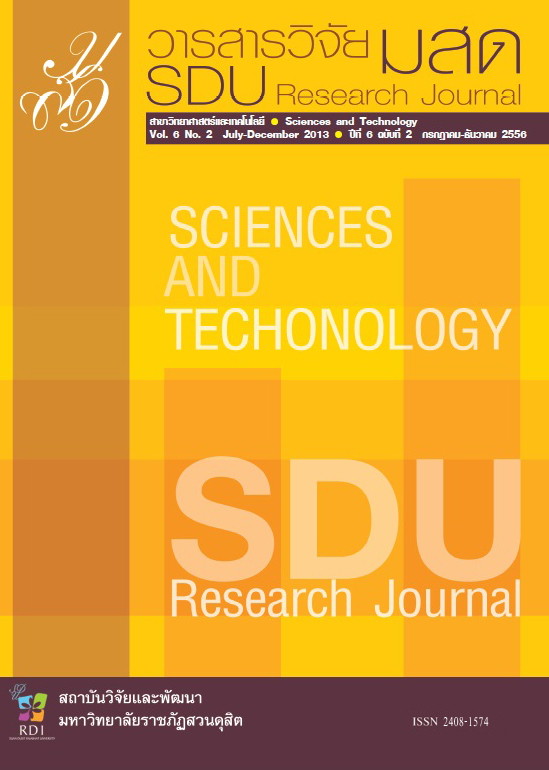การบำบัดน้ำเสียด้วยอีเอ็มก้อน: กรณีศึกษาน้ำเสียตัวอย่างจากคลองแสนแสบ
Keywords:
การบำบัดน้ำเสีย, คลองแสนแสบ, อีเอ็มก้อนAbstract
บทคัดย่อ
การบำบัดน้ำเสียด้วยอีเอ็มก้อน: กรณีศึกษาน้ำเสียตัวอย่างจากคลองแสนแสบ มีวัตถุประสงค์เพื่อศึกษาการเติมอีเอ็มก้อนในอัตราส่วนที่แตกต่างกัน ได้แก่ น้ำเสียตัวอย่างเปล่า, 2.00 : 100, 4.00 : 100 และ 6.00 : 100 (กรัม : ลิตร) ในการบำบัดน้ำเสียในระยะเวลา 3, 6 และ 9 วัน เพื่อวัดประสิทธิภาพในการบำบัดน้ำเสียโดยใช้ตัวชี้วัด ได้แก่ อุณหภูมิ ความเป็นกรดเป็นด่าง ค่าบีโอดี ปริมาณแอมโมเนีย ปริมาณไนเทรต ปริมาณปรอท ตะกั่ว แคดเมียม และปริมาณแบคทีเรียกลุ่มโคลิฟอร์ม ออกแบบการทดลองแบบสุ่มสมบูรณ์ (Completely Randomized Design) จัดรูปแบบ 4×3 Factorial Arrangement จำนวน 2 ซ้ำ
ผลการทดลองแสดงให้เห็นว่าการเติมอีเอ็มก้อนในอัตราส่วน 0 : 100, 2.00 : 100, 4.00 : 100 และ 6.00 : 100 ตัวชี้วัดส่วนใหญ่ ได้แก่ ความเป็นกรดเป็นด่าง ปริมาณแอมโมเนีย ปริมาณไนเทรตและปริมาณแบคทีเรียกลุ่มโคลิฟอร์มมีความแตกต่างกันอย่างมีนัยสำคัญทางสถิติ (p<0.05) ส่วนระยะเวลาในการบำบัด 3, 6 และ 9 วัน ตัวชี้วัดส่วนใหญ่ มีความแตกต่างกันอย่างมีนัยสำคัญทางสถิติ (p<0.05) ยกเว้นอุณหภูมิ (p>0.05) และการเติมอีเอ็มก้อนในอัตราส่วนที่แตกต่างกันและระยะเวลาในการบำบัดที่แตกต่างกัน มีอิทธิพลร่วมกันต่อปริมาณแอมโมเนียของน้ำเสียตัวอย่างจากคลองแสนแสบเพียงตัวชี้วัดเดียว
ผลการทดลองสรุปได้ว่า การใช้อีเอ็มก้อนไม่มีส่วนช่วยในการบำบัดคุณภาพน้ำเสียตัวอย่างจากคลองแสนแสบ เนื่องจากจุลินทรีย์ในอีเอ็มก้อนทำงานได้ดีในสภาวะอับอากาศ ซึ่งไม่สามารถเจริญเติบโตได้ดีแข่งกับจุลินทรีย์ตามธรรมชาติได้
คำสำคัญ :การบำบัดน้ำเสีย คลองแสนแสบ อีเอ็มก้อน
Abstract
The main purpose of this research, wastewater treatment by EM ball: a case study of wastewater from San Sab canal, was to study the use of EM Ball in different ratios with the wastewater sample without EM ball (0 : 100), 2.00 : 100, 4.00 : 100 and 6.00 : 100 (g : l) for 3, 6 and 9 days in order to monitor the effectiveness of treating the wastewater by evaluating temperature, pH, BOD, ammonia, nitrate, mercury, lead, cadmium and total coliform bacteria as indicators with completely randomized design experiment and 4x3 factorial arrangement for 2 replications.
The result of the experiment showed that the wastewater sample with EM ball (0 : 100) and the wastewater sample in 2.00 : 100, 4.00 : 100 and 6.00 : 100 the indicators; pH, ammonia, nitrate and total coliform bacteria, were significantly different in statistics (p<0.05). In the case of the wastewater sample and the wastewater sample with EM ball which was treated in 3, 6 and 9 days, most indicators, excluding temperature (p>0.05), have merely made significantly different in statistics (p<0.05). The use of EM ball in different ratios as well as the different periods of time altogether affected the amount of ammonia in the wastewater sample from San Sab canal.
It can be concluded that, the use of EM ball did not help to treat the quality of the wastewater sample from San Sab canal. because bacteria in EM balls is anaerobic conditioned bacteria which cannot be grow as well as natural bacteria.
Keywords: Wastwater treatment, San Sab canal, EM ball








